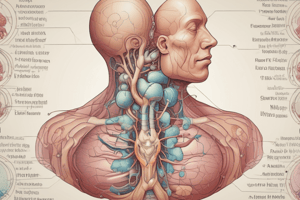Podcast
Questions and Answers
What is the main function of thyroid metabolic hormones T4 and T3?
What is the main function of thyroid metabolic hormones T4 and T3?
- To stimulate O2 consumption by body cells and regulate lipids and carbohydrate metabolism (correct)
- To regulate body temperature
- To produce calcitonin for calcium hemostasis
- To produce thyroglobulin for protein synthesis
What is the percentage of carbohydrate in thyroglobulin by weight?
What is the percentage of carbohydrate in thyroglobulin by weight?
- 5%
- 10% (correct)
- 20%
- 15%
What is the result of hypothyroidism in adults?
What is the result of hypothyroidism in adults?
- Mental and physical slowing, and poor resistance to cold (correct)
- Body wasting and nervousness
- Severe mental retardation and dwarfism
- Excess heat production and tremor
What is the name of the hormone that stimulates the secretion of thyroid metabolic hormones?
What is the name of the hormone that stimulates the secretion of thyroid metabolic hormones?
Where does the synthesis of thyroglobulin take place?
Where does the synthesis of thyroglobulin take place?
What is the role of thyroid peroxidases in thyroid hormone production?
What is the role of thyroid peroxidases in thyroid hormone production?
What is the biological active form of thyroid hormone?
What is the biological active form of thyroid hormone?
What is the function of the colloid in thyroid hormone production?
What is the function of the colloid in thyroid hormone production?
What is the name of the amino acid from which thyroid hormones are synthesized?
What is the name of the amino acid from which thyroid hormones are synthesized?
What is the result of thyroid dysfunctions in fetal and neonatal life?
What is the result of thyroid dysfunctions in fetal and neonatal life?
How is thyroid hormone released from thyroglobulin?
How is thyroid hormone released from thyroglobulin?
What is the first step in the synthesis of thyroid hormone?
What is the first step in the synthesis of thyroid hormone?
What is the percentage of T4 in the thyroid follicle?
What is the percentage of T4 in the thyroid follicle?
What is the primary mechanism of thyroid hormone regulation?
What is the primary mechanism of thyroid hormone regulation?
What is the function of the bound form of thyroid hormones in plasma?
What is the function of the bound form of thyroid hormones in plasma?
What is the primary site of T4 deiodination into T3?
What is the primary site of T4 deiodination into T3?
What is the percentage of T4 that is free in plasma?
What is the percentage of T4 that is free in plasma?
Which of the following plasma proteins has the highest affinity for T4?
Which of the following plasma proteins has the highest affinity for T4?
Flashcards are hidden until you start studying
Study Notes
Thyroid Gland
- Location: Butterfly-shaped in the front of the neck
- Size: The largest endocrine gland in the body
- Secretions: Metabolic hormones (T4 and T3) and calcitonin (for calcium hemostasis)
Thyroid Metabolic Hormones (T4 and T3)
- Function: • Stimulate O2 consumption by body cells • Regulate lipids and carbohydrate metabolism • Influence body mass and mentation
Thyroid Dysfunctions
- In fetal and neonatal life: Absence or hypofunction causes severe mental retardation and dwarfism
- In adult life: • Hypothyroidism: Mental and physical slowing, poor resistance to cold (cold intolerance) • Hyperthyroidism: Body wasting, nervousness, tachycardia, tremor, excess heat production
Thyroid Hormone Synthesis
- Steps: • Transport of iodine into the colloid of thyroid follicles • Iodine oxidation in the colloid • Tyrosine iodination • Endocytosis of thyroglobulin-thyroid hormone into thyrocytes • Thyroid hormone release by cleavage in lysosomes
- T4 is the main secreted hormone, while T3 is the biologically active form
- T4 is converted to T3 in peripheral tissues by deiodination
Thyroglobulin
- Structure: Glycoprotein containing 10% carbohydrate by weight and 123 tyrosine residues
- Synthesis: In the thyrocytes
- Secretion: By exocytosis into the colloid
- Thyroid peroxidases mediate oxidation and reaction of iodine with thyroglobulin
- The produced thyroid hormone remains part of thyroglobulin until needed
Thyroid Peroxidases
- Involved in iodination and coupling of iodinated tyrosine residues
Synthetic Steps in Thyroid Hormone Production
- First step: Iodination of tyrosine to give MIT (monoiodotyrosine)
- Next step: Iodination of MIT at C5 to give DIT (diiodotyrosine)
- Two possibilities then occur: • Two DIT undergo oxidative condensation to form T4 • One DIT condenses with one MIT to form T3 (major) and reverse T3 (RT3 – trace)
Distribution and Secretion
- % Distribution in the thyroid follicle: • T4: 35% • T3: 7% • MIT: 3% • DIT: 33%
- Secretion rate: • T4: 80 μg/day • T3: 4 μg/day • RT3: 2 μg/day • DIT & MIT: null
Plasma Levels and Binding
- Plasma levels: T4 = 8 μg/dL, T3 = 0.15 μg/dL
- Solubility: Both are lipophilic
- In plasma: Present as bound form (bound to plasma protein) + free form (biologically active)
- Free hormone is biologically active and exerts an inhibitory feedback on pituitary TSH secretion
- Plasma proteins that bind thyroid hormones: • Albumin • Prealbumin (Transthyretin) • Thyroxine-binding globulin (TBG)
Metabolic Pathway
- T4 deiodinated into T3 (catabolism and activation)
- Site of metabolism: Liver, kidneys, and other tissues
- Metabolism of T4: 1/3 to T3, 45% to RT3
- T3 supply: 13% secreted by thyroid gland, 87% by deiodination
Studying That Suits You
Use AI to generate personalized quizzes and flashcards to suit your learning preferences.




